Photos from the Yunnan Go Factory
Pong Yen from Yellow Mountain Imports is now in Shanghai after a long trip down to Southern China. He had promised me photos from the Yunnan Go Factory and he sent me several.
 The Yunnan Go Factory is on the former airbase of Claire L. Chenault's Flying Tigers fighter squadron outside of Kunming in Yunnan province.
The Yunnan Go Factory is on the former airbase of Claire L. Chenault's Flying Tigers fighter squadron outside of Kunming in Yunnan province.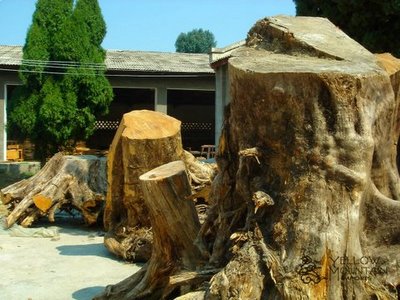 These are old Kaya trees; several hundred years old and from Burma. They are illegal to cut down in China but are allowed to be imported from other countries. Boards made from these are very expensive and highly prized in Japan. YMI does not currently carry boards from these woods.
These are old Kaya trees; several hundred years old and from Burma. They are illegal to cut down in China but are allowed to be imported from other countries. Boards made from these are very expensive and highly prized in Japan. YMI does not currently carry boards from these woods.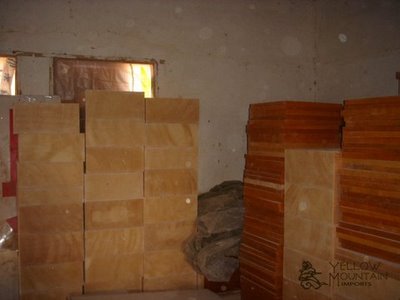 The wood is dried in storage through convection for up to ten years depending on the thickness of the cut.
The wood is dried in storage through convection for up to ten years depending on the thickness of the cut. The standard thickness of a floor goban in China is 20cm. This is too large and heavy for YMI to import at this time. Pong had expressed concerns about how heavier gobans could sustain in-transit damage when I once suggested that YMI should carry a 22cm goban that I had seen online.
The standard thickness of a floor goban in China is 20cm. This is too large and heavy for YMI to import at this time. Pong had expressed concerns about how heavier gobans could sustain in-transit damage when I once suggested that YMI should carry a 22cm goban that I had seen online.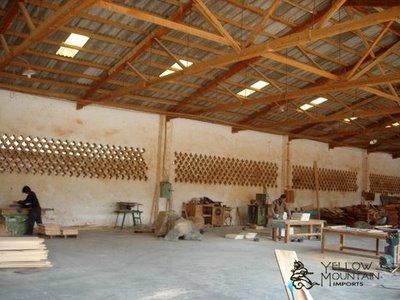 This is the shed where they make the fine cuts for the boards from blocks to actual board size.
This is the shed where they make the fine cuts for the boards from blocks to actual board size. Here, a worker is sanding off some boards.
Here, a worker is sanding off some boards. This is the former bath house of the Flying Tigers. It is now used for carving go bowls, board legs and reliefs for decorative floor gobans.
This is the former bath house of the Flying Tigers. It is now used for carving go bowls, board legs and reliefs for decorative floor gobans. This is a sample of one of the reliefs that are carved in the workshop.
This is a sample of one of the reliefs that are carved in the workshop. The is the master sculpter and engraver. The carving is a time-consuming and highly-skilled craft.
The is the master sculpter and engraver. The carving is a time-consuming and highly-skilled craft. This photo provides a close-up of a panel which will be added to a Chinese-styled floor board.
This photo provides a close-up of a panel which will be added to a Chinese-styled floor board.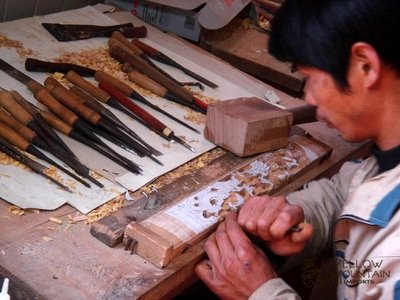 Here is another photo of the carving process using a broad array of chisels and a carvers' mallet.
Here is another photo of the carving process using a broad array of chisels and a carvers' mallet.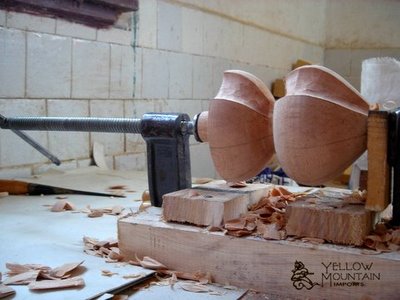 Here's a close-up of a floorboard leg being carved.
Here's a close-up of a floorboard leg being carved. This is the shop storage for floorboard legs after they have been carved.
This is the shop storage for floorboard legs after they have been carved.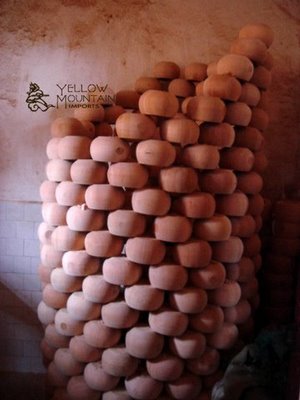 That's an impressive stack of Go bowls. Anyone care to play Jenga?
That's an impressive stack of Go bowls. Anyone care to play Jenga?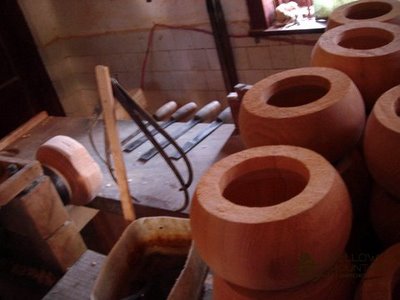 Here's a close-up of the unfinished bowls. That seems to be a turning lathe in the background.
Here's a close-up of the unfinished bowls. That seems to be a turning lathe in the background. Although this photo is blurry, you can clearly see the tiles of the bath house.
Although this photo is blurry, you can clearly see the tiles of the bath house. After the boards are properly dried, they are ready to be painted.
After the boards are properly dried, they are ready to be painted. This is where the table lines are drawn, and where the paint and finish are applied. This part of the compound is the former horse stable of the Flying Tigers.
This is where the table lines are drawn, and where the paint and finish are applied. This part of the compound is the former horse stable of the Flying Tigers. Here, we see a stack of unfinished boards. They look like they were all cut from a single piece of wood.
Here, we see a stack of unfinished boards. They look like they were all cut from a single piece of wood.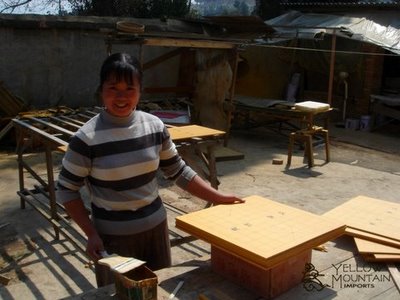 A finish is applied to what look like Chinese chess boards. I can't quite make out those markings on the center.
A finish is applied to what look like Chinese chess boards. I can't quite make out those markings on the center.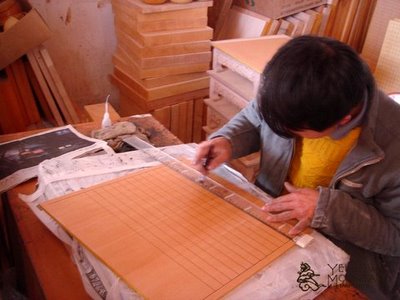 Here is the line-drawing expert applying the lines and star points by hand. My understanding is that some modern Japanese goban manufacturers do use specialized drafting-style equipment to apply the ink for the lines. Contrast this to the traditional method of using a modified sword edge.
Here is the line-drawing expert applying the lines and star points by hand. My understanding is that some modern Japanese goban manufacturers do use specialized drafting-style equipment to apply the ink for the lines. Contrast this to the traditional method of using a modified sword edge. The former barracks of the Flying Tigers airmen now serves as the workers' on-site residences.
The former barracks of the Flying Tigers airmen now serves as the workers' on-site residences. Here are stacks of finished boards which will be part of YMI's upcoming inventory. According to Pong, the Yunan Go Factory provides boards to The Go Gamestore as well.
Here are stacks of finished boards which will be part of YMI's upcoming inventory. According to Pong, the Yunan Go Factory provides boards to The Go Gamestore as well.Pong mentions that YMI is now inspecting its equipment in its China warehouse before it is shipped to the US; allowing them to reject unsatisfactory boards. With the packaging of the gobans, Pong says that YMI is now adding 4cm and 6cm heavy gauge styrofoam packing around all the sides to prevent damage in transit to their customers.
In addition to shopping at their site, YMI also sells some of their inventory at auction on eBay.
 In the foreground is a decorative Chinese-styled goban.
In the foreground is a decorative Chinese-styled goban.That's a wrap for this special article courtesy of Pong! If you'd like to see the goban I had received from YMI back in December, you can head over to that previous post.
Pong continues to hint of some new items being added to their inventory in the upcoming months so I'll be checking their site every now and then. If he gives me a heads-up (and an authorization to release the info), you'll hear the latest on this blog.
In other news
Some of you have noticed my recent absence from KGS. One of my coworkers has gone on maternity leave and I need to help cover for her.
I suddenly have a lot less time for Go but you will occasionally catch me on the servers. I may be lurking and watching games rather than playing.





5 Comments:
It is indeed a xiangqi grid being applied in the photo with the young woman. They offer boards with weiqi on one side and xiangqi on the other. I have such a board purchased through go-gamestore in Canada.
Yes. I've seen such combo boards both at The Go Gamestore and at a local Chinese bookstore (a plywood board for $10).
Whoops, forgot to sign my previous comment. As per the characters on the xiangqi side of the board, I think I read somewhere that they are river/place names with a real geographical/historical basis. Reportedly these names traditionally appearing on most xiangqi boards commemorate an ancient war fought in that area.
Great photos by the way!
- C.S. Graves
Hello CS!
Credit for the photos definitely goes to Pong Yen at Yellow Mountain Imports.
Readers who are curious about xiangqi can learn more on these two sites:
1. Xianqi FAQ
2. An Into to Xiangqi for Chess players
Coming up this weekend will be 500-year-old Yunzi stones and pics from the Go street scene in Guangzhou!
very nice blog
I have pictures on the manufacturing of the stones too :)
see my blog: chengduweiqicenter.blog4ever.com
Post a Comment
<< Home